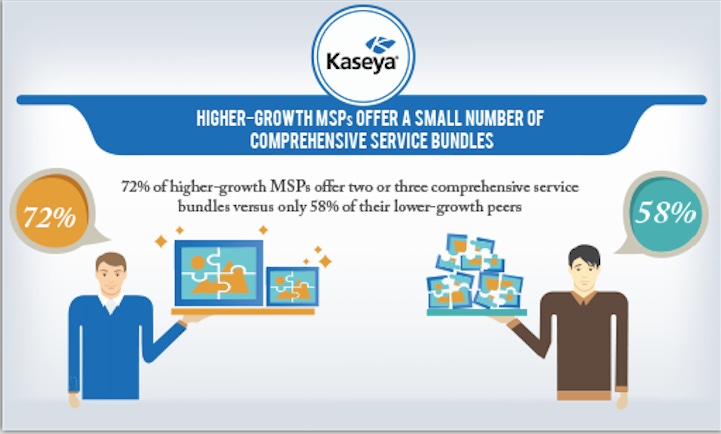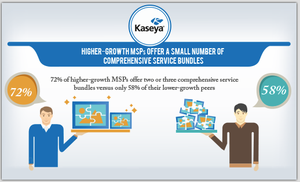High-growth MSPs are 24% more likely to offer a small number of comprehensive service bundles compared to their lower growth peers, according to Kaseya’s last annual MSP survey.
October 12, 2015

By Kaseya Guest Blog 1
 High-growth MSPs are 24% more likely to offer a small number of comprehensive service bundles compared to their lower growth peers, according to Kaseya’s last annual MSP survey.
High-growth MSPs are 24% more likely to offer a small number of comprehensive service bundles compared to their lower growth peers, according to Kaseya’s last annual MSP survey.
It’s easy to see why this may be more than just correlation, and may actually be causal: standardization.
The Magic of Standardization
By standardizing offerings, MSPs can lower service delivery costs along many dimensions to support increased growth and margins:
Sales transactions: Offering a pre-defined suite of services lowers the transactional costs of doing business–from statements of work to SLAs to licensing agreements to onboarding, and so on. With a few comprehensive bundles, you don’t have to start from scratch, building a customized list of services and deliverables.
Staff efficiency: IT staff can focus solely on helping solve client issues without having to research the details of the services, SLAs, etc. In addition, since services are standardized, IT staff proficiency improves and any service optimizations can be easily leveraged for all clients at once. In fact, most successful MSPs start managing by policies and machine groups versus client-by-client or machine-by-machine. They create, update and apply policies to groups of machines, managing exceptions while keeping systems in compliance of predetermined conditions. They aggregate management tasks and think how they can apply changes by machine group (i.e., Exchange servers) across their entire customer base.
Infrastructure: While not a requirement when creating pre-defined service bundles, MSPs should work to standardize devices and software sets across their client base. Again, this makes it much easier to manage, troubleshoot and rebuild when issues occur.
Scaling: By standardizing service offerings, high-growth MSPs are able to more easily scale their client base without having to increase their IT staff at the same rate.
Of course, you will have clients who demand–sometimes for very good reasons–exceptions to your pre-set service levels. However, there is a real difference between negotiating exceptions on occasion versus creating a laundry list of offerings that result in customized offerings for every client.
Setting Service Package Levels
By now, I hope you’re convinced that creating a small set of comprehensive service bundles is a key step to unlocking higher rates of growth and profitability.
How should you establish your service package development efforts?
As my friends would tell you, my first response will be: It depends. Followed by: What do your customers want?
One MSP market can look very different from any other–varying by such things as size of clients, vertical requirements and localized expectations. No blog, no matter how much experience the author has building and running successful MSPs, can provide an answer that is exactly right for you. You have to do research with your current customers and with the customers you’d like to have in the future.
That said, here is a simple approach to help you start your own process:
Bronze Package: Generally speaking, this package is for clients who just want to make sure someone is tending the IT shop while they’re busy running their business.
Monitoring only
Does not include onsite
Silver Package: This package is for clients who see IT performance and availability as integral to the success of their business, but who also have simple, straightforward IT network and infrastructure configurations.
Monitoring
Patching
Anti-virus
May include some defined onsite hours per month that do not roll over or accumulate over time if unused.
Gold Package: These clients may be very similar to Silver Package clients, except they just feel better knowing someone will be onsite occasionally. Or, these clients may have non-standard endpoints that can’t be accessed via remote management.
Monitoring
Patching
AV
Includes onsite
Wait–There’s more!
Now, I’m going to cheat and add in a fourth package. But this package is not meant to be offered to all clients. This package (which I’ll call Platinum,to keep the metals theme) is devised for those high-value clients who want to go even further in their services outsourcing.
Platinum Package: This is for clients who want everything the Gold Package delivers, but also have specific projects, such as replacing existing equipment. In addition, extra services–such as email, Office 365 or data backup–may be selected for Platinum customers. Of course, the more projects per client, the higher the cost of their particular Platinum package.
Includes everything in th Gold Package but includes projects
Not meant for all clients
Every year brings new changes to the technology landscape, and MSPs have to make sure they keep up. Over time, your particular package offerings will need to evolve. Security services, for example, could become a standard component of your Silver Package; or Mobility Management could become so pervasive that mobile monitoring is standard in your Bronze Package.
By looking for ways to standardize and simplify your service packages, you can ensure that you’re defining your clients’ expectations, exceeding those expectations, and optimizing your company’s growth and profitability.
For more insight into the habits of highly effective MSPs, download the entire Kaseya 4th Annual MSP Pricing Survey report, How Leading MSPs Achieve Higher Growth.
Guest blogs such as this one are published monthly and are part of MSPmentor’s annual platinum sponsorship.
You May Also Like
